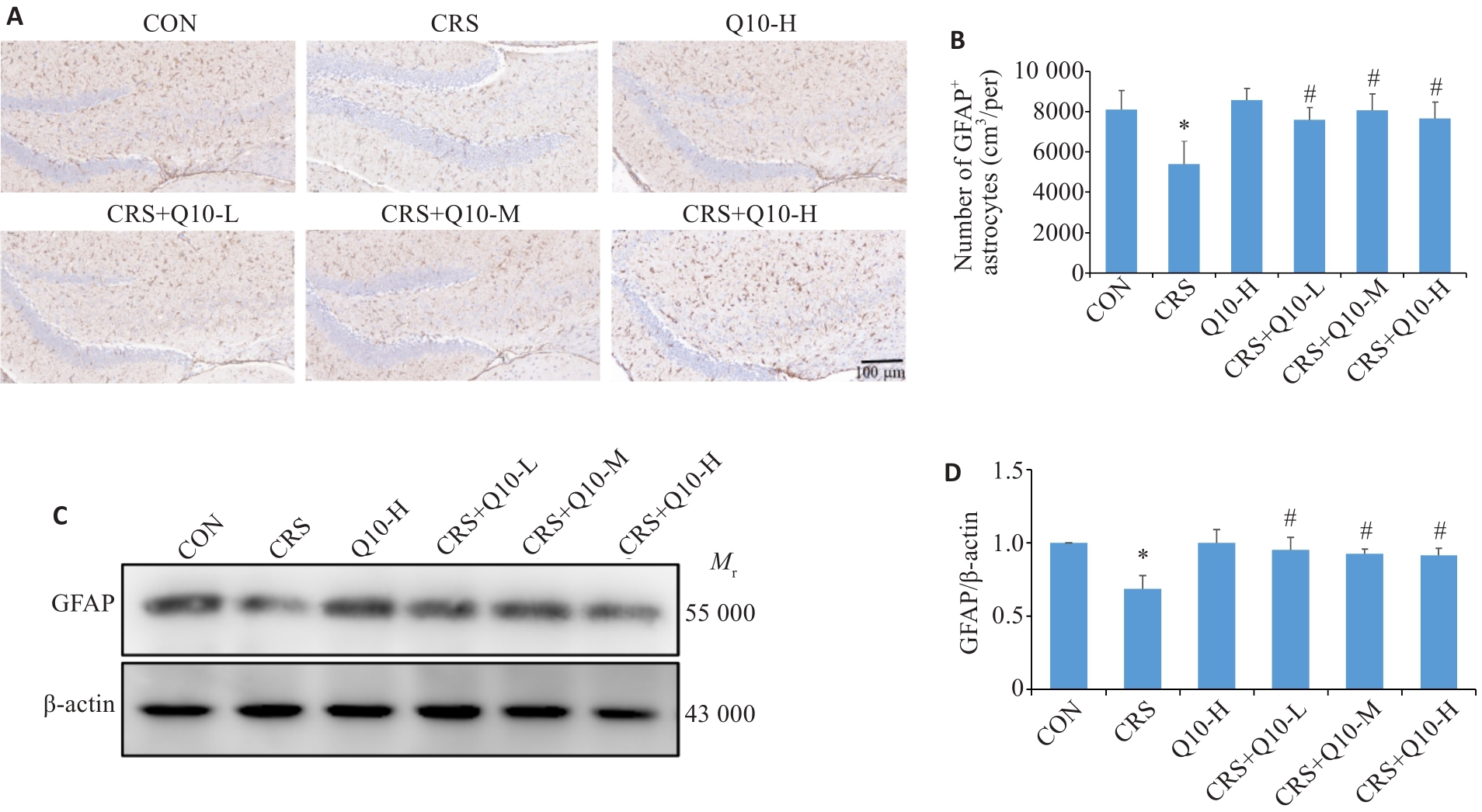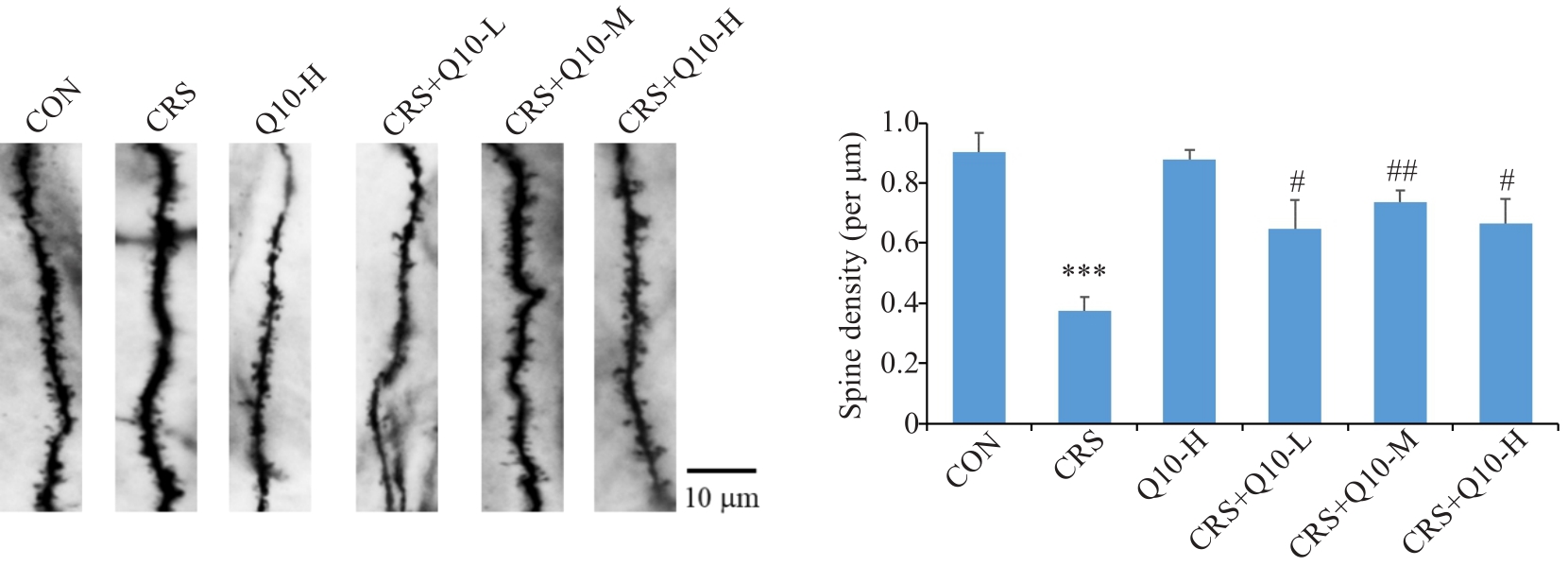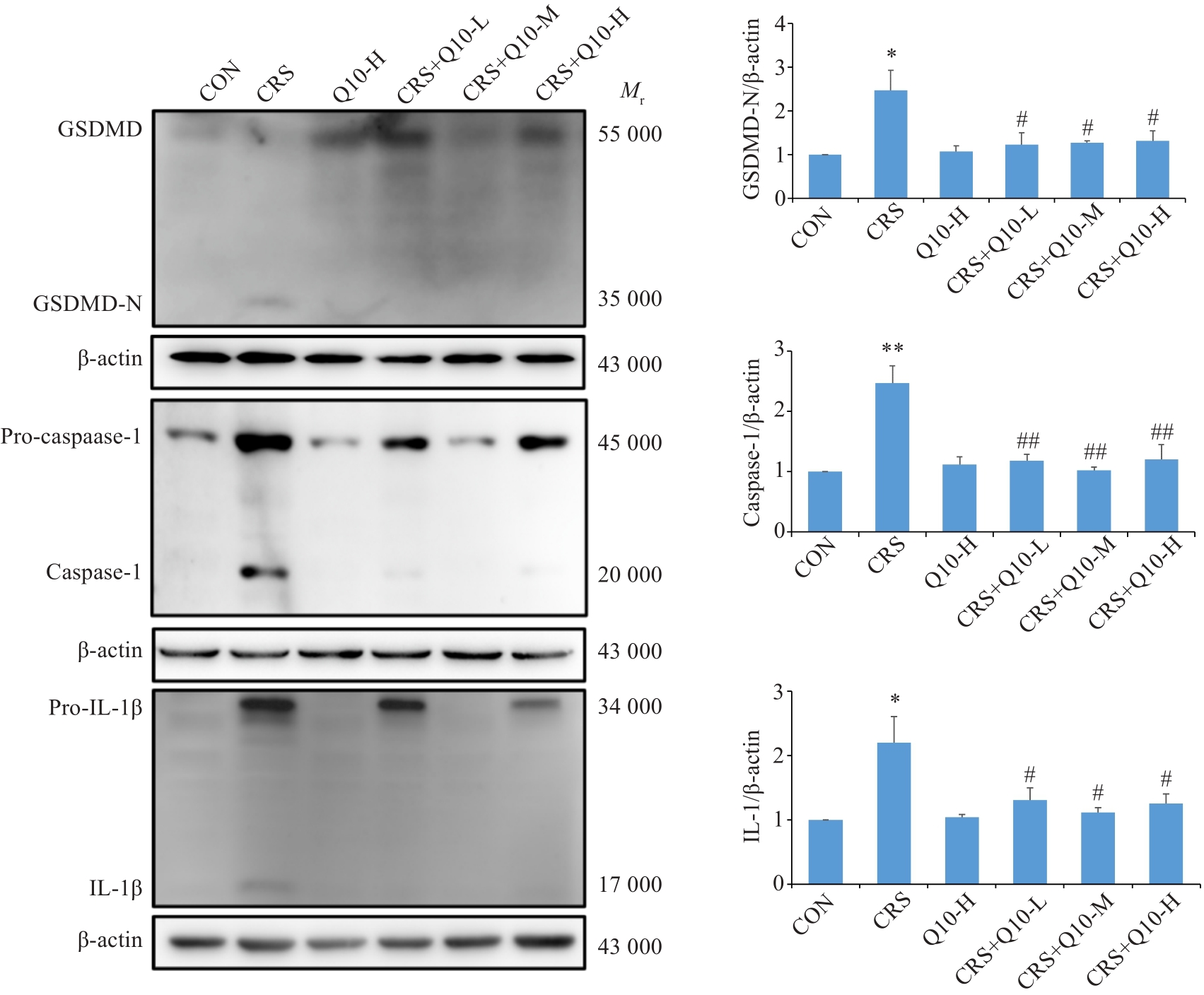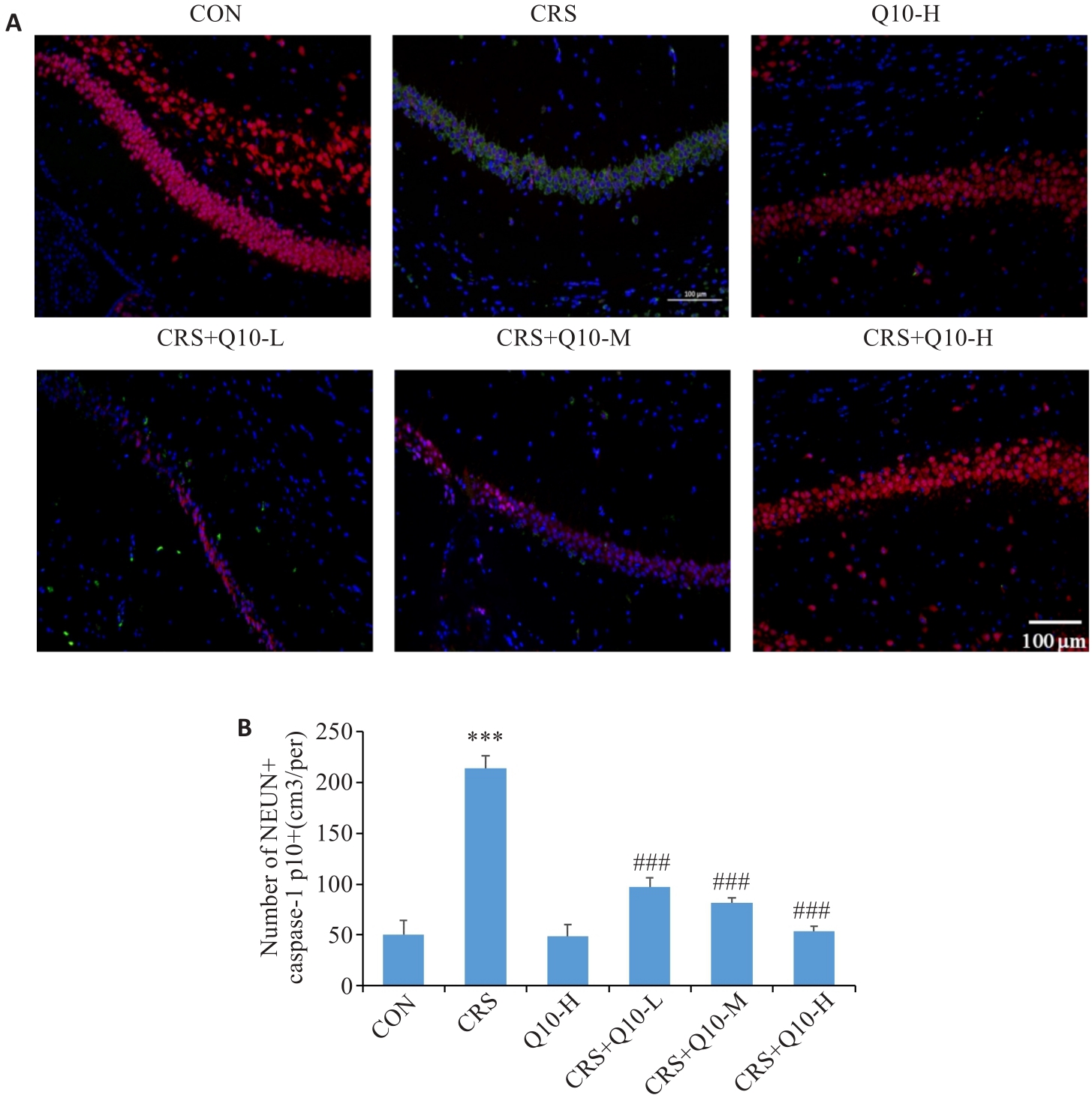Journal of Southern Medical University ›› 2024, Vol. 44 ›› Issue (5): 810-817.doi: 10.12122/j.issn.1673-4254.2024.05.02
• Basic Research • Previous Articles Next Articles
Yiming SUN1,2( ), Rong ZHANG3, Ying MENG3, Lei ZHU3, Mingqiang LI3, Zhe LIU1,2(
), Rong ZHANG3, Ying MENG3, Lei ZHU3, Mingqiang LI3, Zhe LIU1,2( )
)
Received:2024-01-10
Online:2024-05-20
Published:2024-06-06
Contact:
Zhe LIU
E-mail:15951977608@163.com;117915493@qq.com
Supported by:Yiming SUN, Rong ZHANG, Ying MENG, Lei ZHU, Mingqiang LI, Zhe LIU. Coenzyme Q10 alleviates depression-like behaviors in mice with chronic restraint stress by down-regulating the pyroptosis signaling pathway[J]. Journal of Southern Medical University, 2024, 44(5): 810-817.
Add to citation manager EndNote|Ris|BibTeX
URL: https://www.j-smu.com/EN/10.12122/j.issn.1673-4254.2024.05.02

Fig.2 Coenzyme Q10 alleviates the loss of astrocytes in the hippocampus of mice with CRS (Original magnification: ×200). A, B: Immunohistochemistry and positive rate of GFAP in the hippocampus. C, D: Results of Western blotting for detecting GFAP protein expression. *P<0.05 vs CON, #P<0.05 vs CRS.

Fig. 3 Coenzyme Q10 reduces the loss of synaptic spines in the hippocampus of CRS mice (Golgi staining, scale bar=10 μm). ***P <0.001 vs CON; #P <0.05, ##P <0.01 vs CRS.

Fig.4 Coenzyme Q10 reduces expressions of pyroptosis-related proteins in the hippocampus of CRS mice detected by Western blotting. *P<0.05, **P<0.01 vs CON; #P<0.05, ##P<0.01 vs CRS.

Fig.5 Coenzyme Q10 reduces colabeling of caspase-1 p10 and hippocampal neurons in CRS mice. A: Immunofluorescence staining of the hippocampal neurons. B: Number of colocalization of neurons and caspase-1 p10. ***P<0.001 vs CON; ###P<0.001 vs CRS.
| 1 | Davidson RJ, Pizzagalli D, Nitschke JB, et al. Depression: perspectives from affective neuroscience[J]. Annu Rev Psychol, 2002, 53: 545-74. |
| 2 | Davidson JRT. Major depressive disorder treatment guidelines in America and Europe[J]. J Clin Psychiatry, 2010, 71(): e04. |
| 3 | O’Leary LA, Mechawar N. Implication of cerebral astrocytes in major depression: a review of fine neuroanatomical evidence in humans[J]. Glia, 2021, 69(9): 2077-99. |
| 4 | O’Connor S, Agius M. A systematic review of structural and functional MRI differences between psychotic and nonpsychotic depression[J]. Psychiatr Danub, 2015, 27(): S235-9. |
| 5 | Hertz L, Rothman DL, Li BM, et al. Chronic SSRI stimulation of astrocytic 5-HT2B receptors change multiple gene expressions/editings and metabolism of glutamate, glucose and glycogen: a potential paradigm shift[J]. Front Behav Neurosci, 2015, 9: 25. |
| 6 | Domschke K. Clinical and molecular genetics of psychotic depression[J]. Schizophr Bull, 2013, 39(4): 766-75. |
| 7 | Brunet M, van Gelder T, Åsberg A, et al. Therapeutic drug monitoring of tacrolimus-personalized therapy: second consensus report[J]. Ther Drug Monit, 2019, 41(3): 261-307. |
| 8 | Rothschild AJ. Challenges in the treatment of major depressive disorder with psychotic features[J]. Schizophr Bull, 2013, 39(4): 787-96. |
| 9 | Parker G, Roy K, Hadzi-Pavlovic D, et al. Psychotic (delusional) depression: a meta-analysis of physical treatments[J]. J Affect Disord, 1992, 24(1): 17-24. |
| 10 | Sonmez AI, Camsari DD, Nandakumar AL, et al. Accelerated TMS for Depression: a systematic review and meta-analysis[J]. Psychiatry Res, 2019, 273: 770-81. |
| 11 | Vasudevan SO, Behl B, Rathinam VA. Pyroptosis-induced inflammation and tissue damage[J]. Semin Immunol, 2023, 69: 101781. |
| 12 | Kovacs SB, Miao EA. Gasdermins: effectors of pyroptosis[J]. Trends Cell Biol, 2017, 27(9): 673-84. |
| 13 | 祁 宏, 王 洋, 石艳香. 细胞凋亡、坏死和焦亡信号网络关键节点的识别[J]. 河南师范大学学报: 自然科学版, 2024, 52(1): 51-9. |
| 14 | Li SS, Sun YM, Song MM, et al. NLRP3/caspase-1/GSDMD-mediated pyroptosis exerts a crucial role in astrocyte pathological injury in mouse model of depression[J]. JCI Insight, 2021, 6(23): e146852. |
| 15 | Maes M, Mihaylova I, Kubera M, et al. Lower plasma Coenzyme Q10 in depression: a marker for treatment resistance and chronic fatigue in depression and a risk factor to cardiovascular disorder in that illness[J]. Neuro Endocrinol Lett, 2009, 30(4): 462-9. |
| 16 | Lesser GJ, Case D, Stark N, et al. A randomized, double-blind, placebo-controlled study of oral coenzyme Q10 to relieve self-reported treatment-related fatigue in newly diagnosed patients with breast cancer[J]. J Support Oncol, 2013, 11(1): 31-42. |
| 17 | Chiba SC, Numakawa T, Ninomiya M, et al. Chronic restraint stress causes anxiety- and depression-like behaviors, downregulates glucocorticoid receptor expression, and attenuates glutamate release induced by brain-derived neurotrophic factor in the prefrontal cortex[J]. Prog Neuropsychopharmacol Biol Psychiatry, 2012, 39(1): 112-9. |
| 18 | Abuelezz SA, Hendawy N, Magdy Y. Targeting oxidative stress, cytokines and serotonin interactions via indoleamine 2, 3 dioxygenase by coenzyme Q10: role in suppressing depressive like behavior in rats[J]. J Neuroimmune Pharmacol, 2017, 12(2): 277-91. |
| 19 | Zhang Y, Liu L, Liu YZ, et al. NLRP3 inflammasome mediates chronic mild stress-induced depression in mice via neuroinflammation[J]. Int J Neuropsychopharmacol, 2015, 18(8): pyv006. |
| 20 | Jha MK, Jo M, Kim JH, et al. Microglia-astrocyte crosstalk: an intimate molecular conversation[J]. Neuroscientist, 2019, 25(3): 227-40. |
| 21 | Sun MQ, You HL, Hu XX, et al. Microglia-astrocyte interaction in neural development and neural pathogenesis[J]. Cells, 2023, 12(15): 1942. |
| 22 | Sacristán C. Microglia and astrocyte crosstalk in immunity[J]. Trends Immunol, 2020, 41(9): 747-8. |
| 23 | 李爱萍, 赵慧娟, 贾梦阳, 等. 辅酶Q10在代谢综合征和心血管疾病中的研究进展[J]. 中国医药科学, 2022, 12(9): 54-7. DOI: 10.3969/j.issn.2095-0616.2022.09.015 |
| 24 | Yang LC, Calingasan NY, Wille EJ, et al. Combination therapy with coenzyme Q10 and creatine produces additive neuroprotective effects in models of Parkinson's and Huntington's diseases[J]. J Neurochem, 2009, 109(5): 1427-39. |
| 25 | Erol B, Bozlu M, Hanci V, et al. Coenzyme Q10 treatment reduces lipid peroxidation, inducible and endothelial nitric oxide synthases, and germ cell-specific apoptosis in a rat model of testicular ischemia/reperfusion injury[J]. Fertil Steril, 2010, 93(1): 280-2. |
| 26 | Attia HN, Maklad YA. Neuroprotective effects of coenzyme Q10 on paraquat-induced Parkinson's disease in experimental animals[J]. Behav Pharmacol, 2018, 29(1): 79-86. |
| 27 | Forester BP, Zuo CS, Ravichandran C, et al. Coenzyme Q10 effects on creatine kinase activity and mood in geriatric bipolar depression[J]. J Geriatr Psychiatry Neurol, 2012, 25(1): 43-50. |
| 28 | Nasoohi S, Simani L, Khodagholi F, et al. Coenzyme Q10 supplementation improves acute outcomes of stroke in rats pretreated with atorvastatin[J]. Nutr Neurosci, 2019, 22(4): 264-72. |
| 29 | Aboul-Fotouh S. Coenzyme Q10 displays antidepressant-like activity with reduction of hippocampal oxidative/nitrosative DNA damage in chronically stressed rats[J]. Pharmacol Biochem Behav, 2013, 104: 105-12. |
| 30 | Alcocer-Gómez E, Sánchez-Alcázar JA, Cordero MD. Coenzyme Q10 regulates serotonin levels and depressive symptoms in fibromyalgia patients: results of a small clinical trial[J]. J Clin Psychopharmacol, 2014, 34(2): 277-8. |
| 31 | Heimfarth L, Passos FRS, Monteiro BS, et al. Serum glial fibrillary acidic protein is a body fluid biomarker: a valuable prognostic for neurological disease-A systematic review[J]. Int Immunopharmacol, 2022, 107: 108624. |
| 32 | Rajkowska G, Miguel-Hidalgo JJ. Gliogenesis and glial pathology in depression[J]. CNS Neurol Disord Drug Targets, 2007, 6(3): 219-33. |
| 33 | Salehpour F, Farajdokht F, Cassano P, et al. Near-infrared photobiomodulation combined with coenzyme Q10 for depression in a mouse model of restraint stress: reduction in oxidative stress, neuroinflammation, and apoptosis[J]. Brain Res Bull, 2019, 144: 213-22. |
| 34 | Abuelezz SA, Hendawy N, Magdy Y. The potential benefit of combined versus monotherapy of coenzyme Q10 and fluoxetine on depressive-like behaviors and intermediates coupled to Gsk-3β in rats[J]. Toxicol Appl Pharmacol, 2018, 340: 39-48. |
| 35 | Li DX, Wang CN, Wang Y, et al. NLRP3 inflammasome-dependent pyroptosis and apoptosis in hippocampus neurons mediates depressive-like behavior in diabetic mice[J]. Behav Brain Res, 2020, 391: 112684. |
| 36 | Li YJ, Song W, Tong Y, et al. Isoliquiritin ameliorates depression by suppressing NLRP3-mediated pyroptosis via miRNA-27a/SYK/NF-κB axis[J]. J Neuroinflammation, 2021, 18(1): 1-23. |
| 37 | Yang F, Zhu W, Cai XF, et al. Minocycline alleviates NLRP3 inflammasome-dependent pyroptosis in monosodium glutamate-induced depressive rats[J]. Biochem Biophys Res Commun, 2020, 526(3): 553-9. |
| 38 | Younus I, Reddy DS. A resurging boom in new drugs for epilepsy and brain disorders[J]. Expert Rev Clin Pharmacol, 2018, 11(1): 27-45. |
| [1] | XIONG Yifan, LIANG Xiaoshan, LIANG Xiaotao, LI Weipeng, QIAN Yixiao, XIE Wei. Saikosaponin a alleviates pentylenetetrazol-induced acute epileptic seizures in mouse models of depression by suppressing microglia activation-mediated inflammation [J]. Journal of Southern Medical University, 2024, 44(3): 515-522. |
| [2] | FANG Shangping, SUN Renke, SU Hui, ZHAI Kecheng, XIANG Yu, GAO Yangmengna, GUO Wenjun. Chlorogenic acid alleviates acute kidney injury in septic mice by inhibiting NLRP3 inflammasomes and the caspase-1 canonical pyroptosis pathway [J]. Journal of Southern Medical University, 2024, 44(2): 317-323. |
| [3] | LI Xinyi, LIU Yujie, DENG Kechong, HU Yikui. Modulating gut microbiota improves neurological function and depressive symptoms in rats with post-stroke depression [J]. Journal of Southern Medical University, 2024, 44(2): 405-410. |
| [4] | KONG Xiang, ZHANG Teng, ZHANG Yan, GAO Linxi, WANG Wen, WANG Mengyan, WANG Guodong, LÜ Kun. Overexpression of lncRNA HEM2M alleviates liver injury in mice with non-alcoholic fatty liver disease [J]. Journal of Southern Medical University, 2024, 44(1): 1-8. |
| [5] | WU Di, WANG Xiaole, GAO Yating, TONG Jiabing, YANG Qinjun, DING Huanzhang, ZHANG Lu, LI Zegeng. Shenqi Wenfei Formula alleviates chronic obstructive pulmonary disease in rats with pulmonary qi deficiency syndrome by regulating NLRP3/GSDMD pyroptosis pathway [J]. Journal of Southern Medical University, 2023, 43(9): 1500-1508. |
| [6] | ZHENG Yijun, HOU Yuyue, LI Fan, SHI Xinke, TAO Yawen, ZHAO Xinyu, HU Hao, YANG Lin. Near-infrared light therapy ameliorates depression-induced intestinal dysfunction in rats possibly by activating PGC-1α/Nrf2 signaling and increasing hippocampal BDNF expression [J]. Journal of Southern Medical University, 2023, 43(9): 1591-1598. |
| [7] | LI Hongtao, DENG Yu, WANG Tianle, HUANG Keyong, YU Chuanpei, CHEN Chaojun. Danshenxinkun B protects human umbilical vein endothelial cells against ox-LDL-induced injury by inhibiting pyroptosis and the NF-κB/NLRP3 pathway [J]. Journal of Southern Medical University, 2023, 43(8): 1425-1431. |
| [8] | ZHANG Meng, ZHANG Yuanyuan, NIU Mengzhu, ZHU Yue, TONG Shiyi, KOU Xianjuan. Dihydromyricetin alleviates pyroptosis and necroptosis in mice with MPTP-induced chronic Parkinson's disease by inducing autophagy [J]. Journal of Southern Medical University, 2023, 43(8): 1268-1278. |
| [9] | LI Peipei, HU Yinqi, LIU Jia, WANG Lina, WU Yuanjie, HU Jianpeng. Naoluo Xintong Decoction activates caspase-1/Gasdermin D pathway to promote angiogenesis of rat brain microvascular endothelial cells after oxygen glucose deprivation/reperfusion injury [J]. Journal of Southern Medical University, 2023, 43(7): 1093-1101. |
| [10] | JIANG Yong, GE Wenting, ZHAO Ying, WU Yuge, HUO Yiming, PAN Lanting, CAO Shuang. LINC00926 promotes pyroptosis of hypoxia-induced human umbilical vein vascular endothelial cells by recruiting ELAVL1 [J]. Journal of Southern Medical University, 2023, 43(5): 807-814. |
| [11] | YANG Hui, WANG Hua, LI Chenglong, HE Xiong, LEI Shihui, LI Wei, MENG Pan, WANG Jinxi, LIU Jian, WANG Yuhong. Zuogui Jiangtang Jieyu Decoction promotes neural stem cell self-renewal and activates Shh signaling in the hippocampal dentate gyrus of diabetic rats with depression [J]. Journal of Southern Medical University, 2023, 43(5): 694-701. |
| [12] | XIONG Ziyu, ZHOU Lepeng, CHEN Jingfen, LI Meng, XIE Rihua. Association between postpartum depression and concentrations of transforming growth factor-β in human colostrum: a nested cohort study [J]. Journal of Southern Medical University, 2022, 42(9): 1426-1430. |
| [13] | XIONG Fengmei, LIU Ruiping, LI Yang, SUN Na. Honokiol reduces doxorubicin-induced cardiotoxicity in vitro by inhibiting pyroptosis via activating AMPK/Nrf2 signaling [J]. Journal of Southern Medical University, 2022, 42(8): 1205-1211. |
| [14] | LI Jiaxin, XIAO Yan, LIAO Juan, YANG Chunxia. Temporal trend and contributing factors of depressive symptoms in Chinese menopausal women: analysis based on CHARLS panel data [J]. Journal of Southern Medical University, 2022, 42(7): 1038-1043. |
| [15] | FANG Shangping, YUAN Ran, SUN Renke, MA Tongjun. Knockout of S1PR3 attenuates acute lung injury in mice by inhibiting the MAPK pathway [J]. Journal of Southern Medical University, 2022, 42(12): 1815-1821. |
| Viewed | ||||||
|
Full text |
|
|||||
|
Abstract |
|
|||||